#Euro-Style-Terminal-Blocks
Explore tagged Tumblr posts
Text
https://www.futureelectronics.com/p/interconnect--terminal-blocks--euro-style/221-412-ve00-2500-wago-3062746
Connectors, Terminal Blocks, Pluggable Terminal Blocks, 221-412/VE00-2500, WAGO
221 Series 2 Conductor AWG 24 – 12 Transparent Body Connector w/Levers
#Connectors#Terminal Blocks#Pluggable Terminal Blocks#221-412/VE00-2500#WAGO#terminal block jumper#din rail terminal blocks#socket#Circular Connectors#terminal block jumper wire#din terminal block jumper
1 note
·
View note
Link

#Brass-Terminal-Blocks#Euro-Style-Terminal-Blocks#Modular-Terminal-Blocks#Pluggable-Terminal-Blocks#Electrical-Terminal-Blocks#Power-Blocks#Test-Terminal-Blocks#Universal-Terminal-Blocks#ITALY
0 notes
Link
221 Series 3 Conductor AWG 24 – 12 Transparent Body Connector w/Levers
1 note
·
View note
Link
Terminal Blocks & Barrier Strips, Cable Assemblies, Circular Connectors, Solar Combiners, Rectangular Plastic & Industrial Connectors, Tools, Contacts or Accessories
1 note
·
View note
Link
Euro style connectors are low-voltage pluggable terminal blocks that are widely used in audio applications. They are also used in test, and measurement applications. Euro style terminal blocks are solderless connectors and use screw terminals to connect wires. categorized by type, wire gauge, style, number of poles, termination, and packaging type for easy selection.
1 note
·
View note
Link
COMPACT splicing connectors for all wire types; 5-conductor terminal block; with operating levers; Max. operatung temperature 85°C
1 note
·
View note
Link

#Meter-terminal-parts#meter-Terminal-Blocks#Brass Terminal Blocks#Printed Circuit Board Terminal Blocks#Regular Duty Terminal Blocks#Heavy Duty Terminal Blocks#Euro Style Terminal Blocks#Modular Terminal Blocks#Pluggable Terminal Blocks#Italy
0 notes
Text
Day 178: ...and We’re Still in Bruges
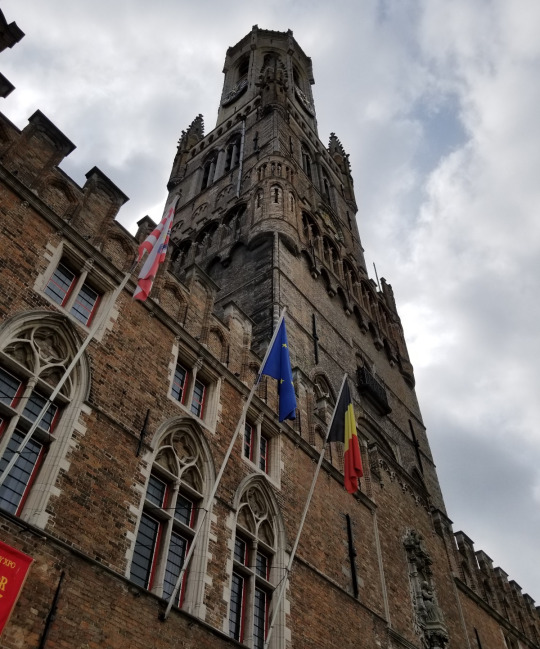
After a pretty intense day visiting the WWI battlefields and memorials of Flanders Fields, Jessica and I decided to spend our last day in Bruges enjoying some of the lighter things it had to offer: chocolate, fries, and a whopping bell tower.

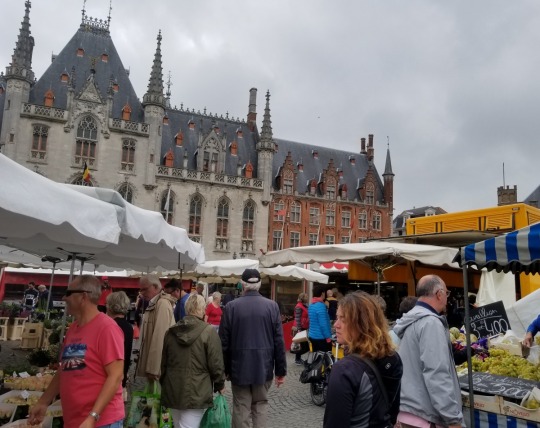

After a return trip to the I Love Coffee espresso bar and a walk through the market square---this time filled with stalls of flowers and produce---we started the day with a trip to Bruges's Choco-Story museum.

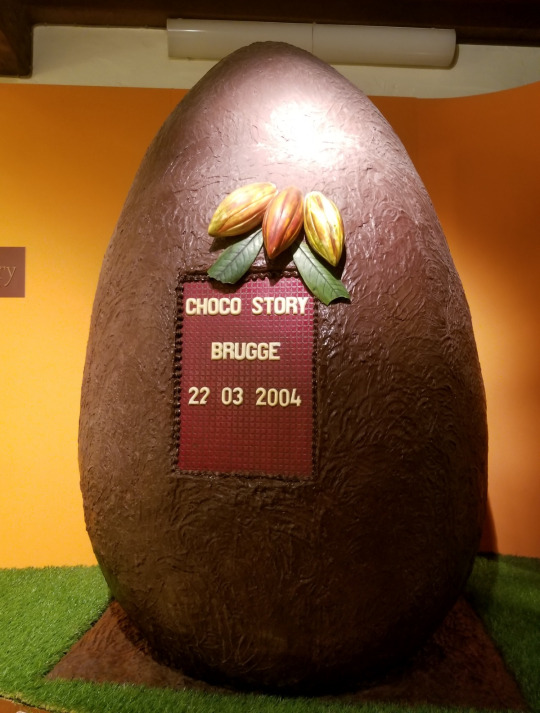
We'd visited a different chocolate museum back in York, so we were interested to see how the chocolate museum in this other world capital of chocolate compared. A lot of the subject material was similar---obviously---but we found the Bruges museum much more interesting. Instead of a flashy guided presentation like we experienced at the York Chocolate Story, the Bruges Choco-Story is an actual museum filled with informational displays that we could take in at our own pace.
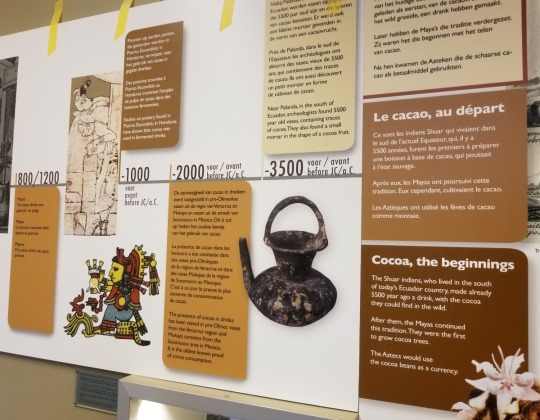
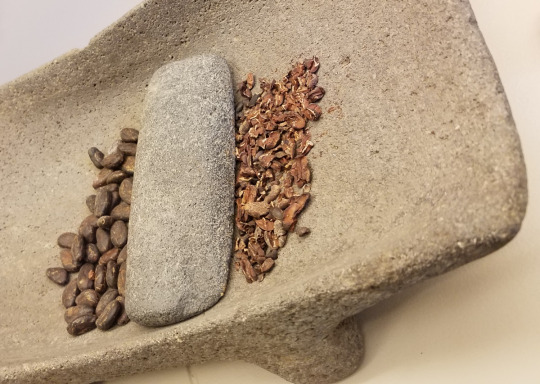
As we already knew, the earliest form of chocolate was a sort of cold bitter tea brewed in Central America from cocoa nuts.. What I hadn't known is that the word chocolate is derived from the Nahuatl (Aztec) word cacahuatl, meaning "cocoa water." The earliest known use of cocoa was by the Shuar people of Ecuador around 5,000 years ago. Archeologists have found traces of Shuar pottery still coated with traces of brewed cocoa.

The later Mayan and Aztec civilizations especially favored a type of foamed cocoa made by churning it with a special whisk. The foam apparently cut down the bitter taste of the unsweetened chocolate.
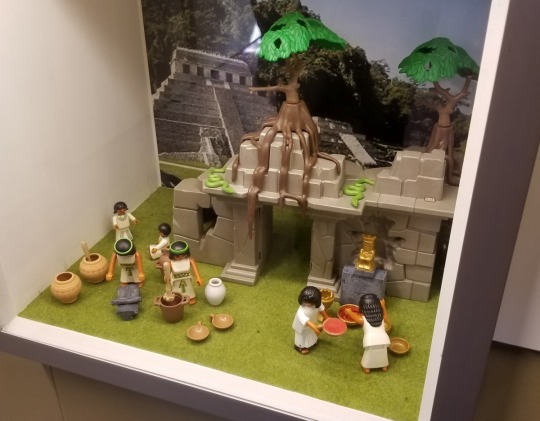
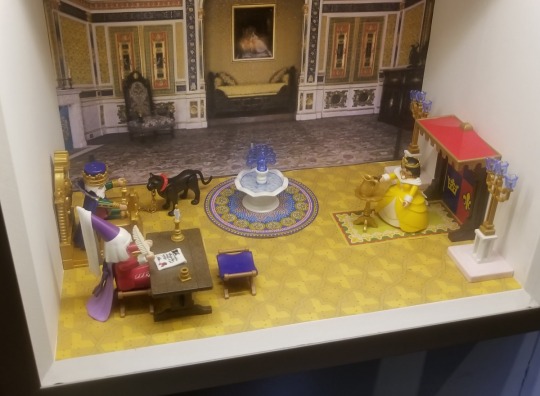
In addition to the more typical museum displays, the Choco-Story also had some delightful Duplo block dioramas.

Much later, Spanish nuns in Oaxaca were the first to add sugar to their cocoa. The drink became so popular among female Spanish colonists that they couldn’t even make it through church services without taking a break for their servants to bring them more. A local bishop tried to crack down on the problem by banning cocoa in church and was found murdered shortly thereafter. (An important lesson about men trying to get between a woman and her chocolate…)
It was nearly a century after Columbus’s first voyage before cocoa made it back to Spain, and it was another century after that before it became popular outside of Spain. But when it finally did, it quickly became a sensation across the continent. In the 1700s, the French philosopher Voltaire mixed cocoa with coffee to create the world’s first mocha. He drank over 40 cups of it per day---to his doctor’s great distress.

Apparently, people were so afraid of spilling their cocoa that a new type of saucer was invented with a basket or cup for holding the cup secure. Maybe they were so afraid of spilling it because it was so expensive. In 1800, a pound of chocolate cost five times the average daily wage.
It wasn't until the mid-1800s that solid chocolate as we know it was first developed by the Quakers of northern England, whom we'd learned about at the Chocolate Story in York. But even though the English invented solid chocolate, the Belgians would argue that they perfected it.



Belgian chocolatiers pioneered the use of fun shapes and fillings to make chocolates even more enjoyable. Belgium was also one of the first countries to impose strict purity laws governing the production of chocolate---sort of like what Bavaria did with beer centuries earlier.
We also learned a bit about the process of making chocolate. (Or rather, I learned, since Jessica was already well-versed in the making of chocolate as a former chocolatier herself.)
I learned that there are three main varieties of cocoa plant: Criollo, Forastero, and Trinitario. Of these, Criollo makes the best chocolate and Forastero makes the least-good chocolate. Still, Forastero is much easier to grow than the other two, so the vast majority of chocolate is made from Forastero beans.
On average, one cocoa tree produces enough nuts to make just one pound of dark chocolate per year. That means that it takes literally billions of cocoa trees to feed the world's sweet tooth.

They also had a diagram showing the composition of dark, milk, and white chocolate. I knew that milk chocolate has a lot more sugar and less cocoa than dark chocolate, but seeing the pie charts really drove the difference home for me.
We also got to eat as many sample pieces of dark, milk, and white chocolate as we wanted, which was nice.

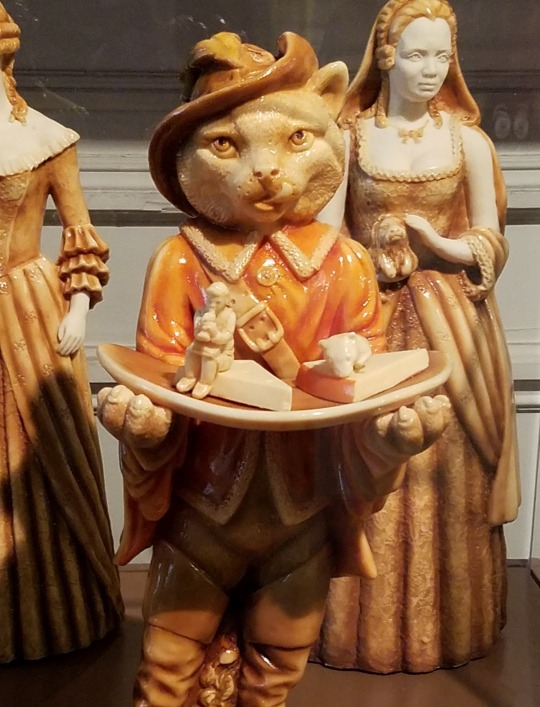

The museum ended with a walk through some incredible chocolate statuary and a demonstration of how to make Belgian pralines. It was pretty much exactly like the demonstration we saw in York---the chocolatier filled a mold with chocolate, poured it out, filled with filling, then filled with chocolate. But it's always fun to see people make chocolate, and it's even better to get free samples afterward.

On our way out to the gift shop, a set of computer terminals offered to reveal our perfect origin chocolate based on our taste preferences. Apparently mine is Venezuela and Jessica’s is Vietnam.

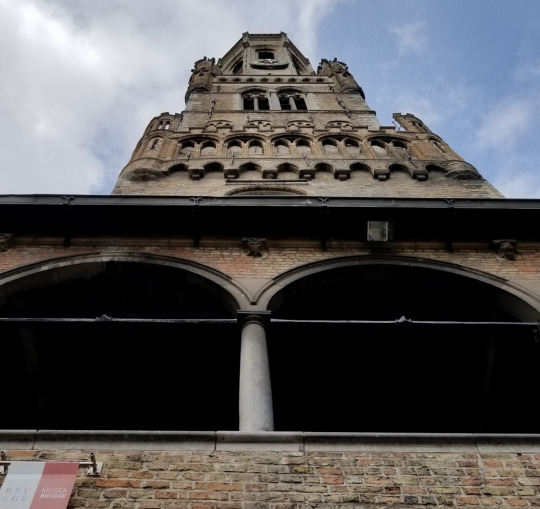
Our next stop was to climb the iconic bell tower that overlooks the market square. I have to admit that I spent a lot of that time thinking about the movie In Bruges, in which the tower plays a prominent role.
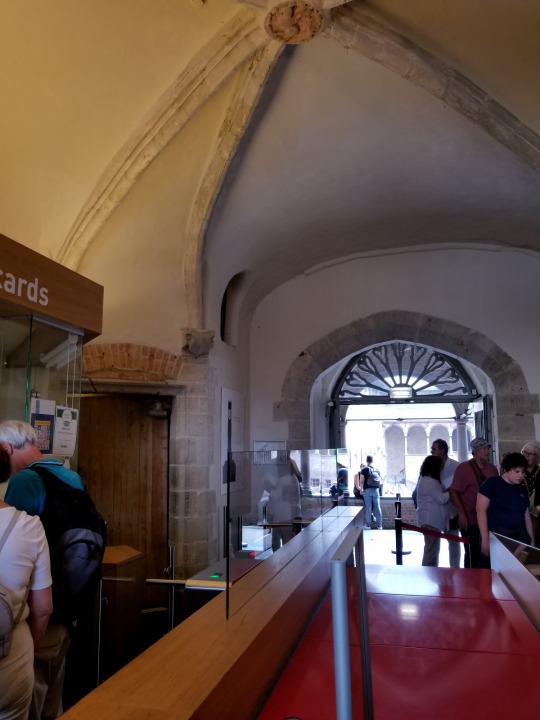
Crowds have apparently become more of an issue in the ten years since the movie was released. It was about a thirty-minute wait in the newly installed queue room before we could climb the tower. The price has also grown along with the crowds–twelve euros per person instead of the five quoted in the movie.

While we waited, we watched a looping video showing how the design of the tower has evolved over time. It was once actually even taller than it is now.
During the Middle Ages, a lot of towns around Belgium made deals with the local lords. The lords gave the towns economic autonomy, and the towns used this freedom to make astronomical amounts of money that the lords could use to raise armies when necessary. Each town had a market hall where local merchants would keep their wares safe during winter, and it became a point of pride for each town to build the biggest, most elaborate tower possible on their market halls.

As we climbed up, we got to see some exhibits along the way. We saw an old lock-box and the original wrought-iron doors dating back over 700 years to the hall’s original construction. Back in the day, this chest would have contained important contracts and decrees, and it would have required multiple respected members of the community to open it together, since they each would carry one of several keys that were all needed to open it.

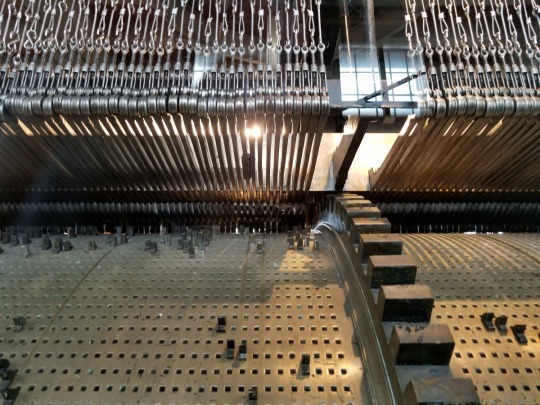
We also saw the giant brass cylinder that runs the tower’s carillon bells just like a music box. I hadn’t known before this trip that that was how they worked!

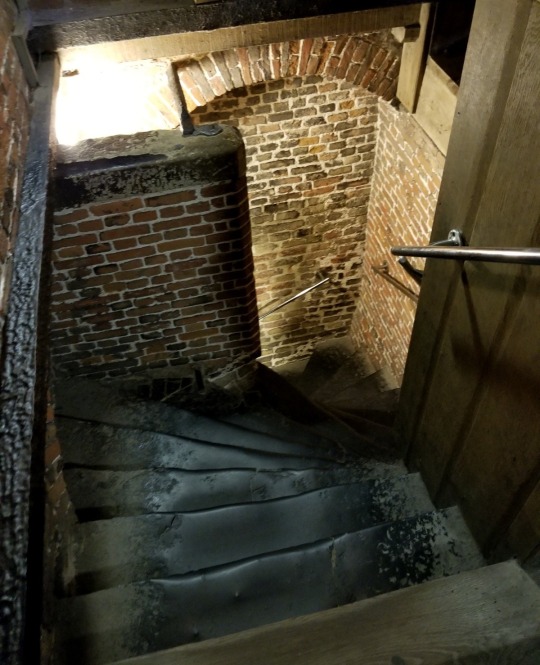
It's very clear from the inside how much the tower has been expanded and renovated over the centuries. The designs and angles of the staircase change dramatically every few floors or so, seemingly without any care for convenience or continuity. It clearly feels like a place that was originally intended to be behind the scenes and not seen by visitors.
Also, as far as I could tell, there wasn't any point along climb where the stairway matched the one shown in In Bruges. Oh well.

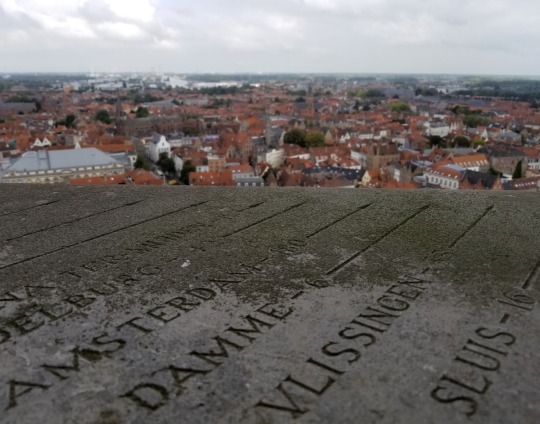
The view from the top of the tower was just as spectacular as we could have hoped. There was a web of wire mesh covering all the windows, possibly to prevent people from inadvertently reenacting the film’s climactic scene.


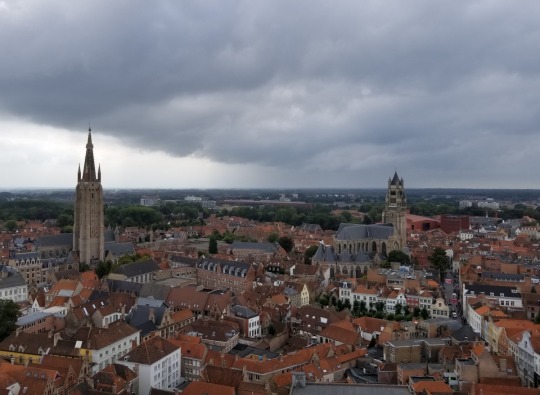
Still, we were able to get some spectacular shots of the surrounding town and skyline.
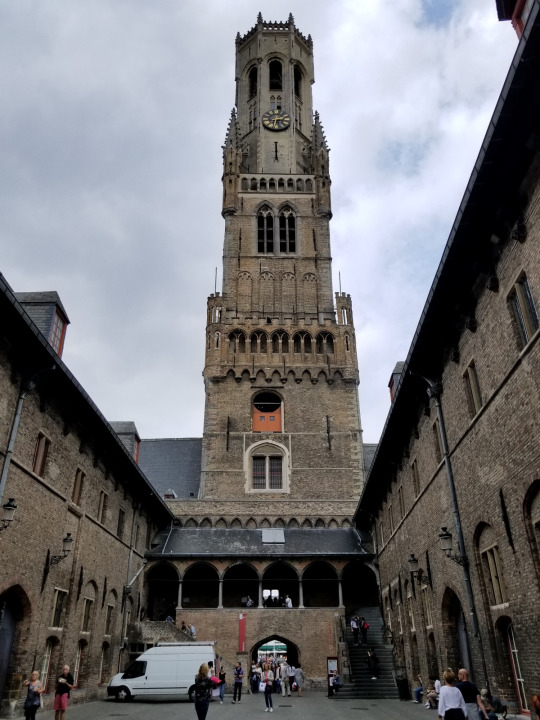
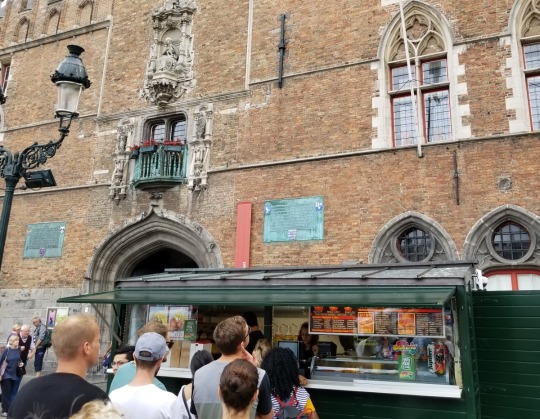
Back on the ground, we bought some fries at one of the stands flanking the entrance and sat down in the bell tower's courtyard. Fries are a big deal in Belgium, and there are dozens of condiments to choose from. There's the American staple of ketchup, the Belgian staple of mayonnaise, and a host of other sauces we'd never heard of before. Thankfully we had plenty of time in line to do some quick research on our phones.
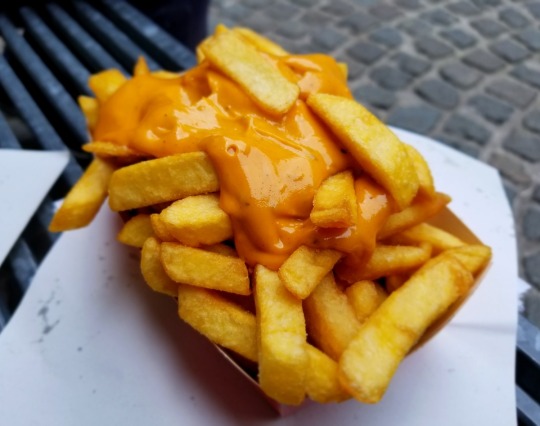
We both settled on “Andalouse sauce”–a blend of mayonnaise, tomato sauce, and peppers. If you've ever tried Red Robin's Campfire sauce before, it is very similar to that. They were easily the best fries either of us have ever had.
After doing a bit of final shopping in town, we headed back to our Airbnb to rest up and get packed for the next day's trip up to Amsterdam, where Jessica’s brother Nic was already waiting for us. We were leaving a day earlier than we had originally planned at the beginning of the trip since we'd gotten tickets to a soccer match in Amsterdam tomorrow night, but we still had a great time. Belgium seems to have a bit of a reputation for being an underwhelming tourist destination, but we had a fantastic time. The people were great, the food was great, the beer was great, and the scenery was great.
Speaking of beer, we didn't do any other beer-related activities after the De Halve Maan brewery tour, but we did our best to sample the local offerings back at our Airbnb in the evenings. We enjoyed a bottle of Kasteel Rouge, the cherry-liqueur-fortified dark ale we'd tasted back in Prague. Just like before, the first sip was heavenly, but each sip afterward was increasingly cloying. It would make a great digestif, but a full bottle---or even half a bottle---is far too much.
Another ale we enjoyed was the ubiquitous but still impressive Leffe Brown. It is the standard dubbel offering of the Belgian abbey-style macrobrewery Leffe, part of the Anheuser-Busch InBev family. But like I said, it is still really good. As long as you like dark ales, that is. The first thing that struck me was just how appropriate the name was. Sure, "Brown" doesn't seem like the most unique or descriptive name for a dark beer, but I can't think of a better word to encapsulate its flavor. It's earthy, bready, and nutty---like drinking a fermented organic bakery.
And of course, we got some Lambic beers. Jessica had gotten me into Lambic beers back when we were first planning this trip. Technically, Lambic beer is just beer that's produced in a very specific part of Belgium using wild yeast instead of brewer's yeast. But commercially, Lambic beers are known for being mixed with fruit syrups to create a deliciously refreshing beverage that even people who don't normally like alcohol can enjoy. The main brand you can find in the US is Lindeman's, and one of the first drinks we opened upon our arrival in Bruges was a Lindeman's Framboise (raspberry). It tasted pretty much the same as it does in the US--which could be seen as either mildly disappointing (since it wasn't any better) or moderately encouraging (we don't have to feel depressed for not getting "the good stuff" back home).
Plus, we also had a ton of chocolates we had to eat our way through. Yeah, life was pretty hard for us in Belgium. But all good things in this life must come to an end, even if it is only to move on to the next good thing. And the next good thing for us was Amsterdam, a family reunion, and my first European soccer match.
#180abroad#bruges#belgium#travel#chocolate#bell tower#french fries#architecture#europe#beer#lindeman#still in bruges
1 note
·
View note
Text
Thank heavens we took the chance on eating at the local restaurant, Rhondda taking on the rabbit stew and Allan going for the famous fish soup. Both were amazing with flavours to die for. The restaurant took a liking to us and threw in a date-pie with ice cream laced with nuts. Beautiful.
As always the night before departure is always restless, constantly waking up to ensure you do not miss your flight. No problems though with the 3am rise and our taxi took us straight to the airport where we were early enough to jump in front of two bus loads of tourists. The only problems being the breakfast the motel had given us was basically forbidden through customs.
The flight was a little early and no issues other then being asked to pay three euro for a cup of tea. No breakfast until we landed in Frankfurt for a five hour stopover. The joys of flight travel. Lufthansa Airlines need to review this policy I feel.
The airport itself is huge. We did not have to leave our terminal with 69 plane docking ports. To do a connection with another airline though you need to leave through customs to go through the whole thing again. The queue for people waiting to do this at least 100 metres long.
Not to be beaten we also took the opportunity to try a frankfurt in Frankfurt. Pretty good but really not that different to what we have at home with all the various additives. Still nice to try.
Our plane was an hour late so what we had planned to on arrival after checking in went out the window. A fast and I mean fast taxis ride from the airport we arrived at our motel which is old but very clean with all the basic needs. The manager, George, s true gentleman helped us prepare tomorrow giving some sound advise, savings is a few dollars.
Unpacked and ready to rumble we headed off to find a bar. No bar just lots of tapas restaurants that all sell beer. Selected a small one about three blocks from our motel (actually only one but we got lost coming home so it end up being three blocks) and it was amazing. The food served was traditional and the Indian beer, coloured red, cold. Only had one of the Indian beer let’s you understand the style and taste. Haha
The meal though was the traditional Francesinha Sandwich famous food from Porto with day old bread with ham, chicken, cheese and sausage in between with egg on top with a lovely rich sauce. Beautiful but should have only bought one between us. Huge sizings.
Home now and heading off to bed. Tomorrow we have so much planned and so little time to do within.
1 note
·
View note
Link
Euro style connectors are low-voltage pluggable terminal blocks that are widely used in audio applications. They are also used in industrial control, test, and measurement applications. Euro style terminal blocks are solderless connectors and use screw terminals to connect wires. categorized by type, wire gauge, style, number of poles, termination, and packaging type for easy selection.
1 note
·
View note
Text
I did it, I feel I was able to successfully conquer Rome as a traveler. Rome has been on my dream list for a while, well, to be honest, I dream of visiting a lot of cities. Still, Rome was at the top of my list and I am so glad I was able to experience this robust and unique city. I hope this guide helps you in your travels and that when you visit Rome it is all you ever thought it would be.
Successfully Conquer Rome as a Traveler
Traveling to Rome for the first time
Language
This was my first time in a country where English was not their first language and I have to say that made me a bit nervous. There really was no need to be nervous, plenty of native Italian speak English. Still, you want to put the effort into learning a few key phrases to make your life easier. Below is an infographis that lists the ones that I think were most useful to me while I was there.
Clothing
While Rome is known to be very stylish, there is a wide breath in that style. What I mean is no matter what you pack you will be in style and fit in just fine. When I travel I remind myself that I am not there to impress anyone. I pack very light as not to have to check any baggage. Waiting for luggage is time out of my exploring. If you want tips on how to pack carry on only please check out my post 7 tips to be carry on only.
Comfort rules
Dress for comfort as Rome requires a fair amount of walking. My friend and I put in well over 46 miles in just 7 days. Make sure your shoes are comfortable as the pavement is quite uneven and there are a lot of stairs. Dress in layers it can be cool in the morning and then heat up in the midday.
Best time to visit Rome and Venice
You will find that Rome is busy all the time but spring and fall seem to be the off periods. You will find the weather is more favorable in spring and fall. While I was there in early October it was 60-75 daily. We had one day of rain and even then it wasn’t too bad. So my suggestion is to look to visiting in Late April – Early June and then again Late September thru Late October.
Exploring Rome on your own
Safety
First, let me address safety, the one thing that might have made me really think twice about wandering alone. If you use common sense then you will be fine. I never once felt unsafe or uncomfortable while I was wandering Rome. There many nights we were out wandering the streets well into the evening hours.
Keep your purse close and closed, pickpockets do exist, we had an experience with one in the metro (future post 11/27). Protect yourself and your property, I suggest this travel bag from Travelon, it has locks on the main sections and is a cross body style that makes it comfortable to walk around all day.
Otherwise, I felt completely safe while I was in Rome. We rode the Metro (subway), the city bus, took trains (both public and high speed) and taxies. The only thing we didn’t get a chance to ride was the trolley. Well, I guess that means I will have to go back for that experience.
Things to avoid in Rome
The termini at late night –
The main station in Rome is the termini or terminal it is probably the only place I felt a bit uneasy at night. I have to say that out of all the areas I covered in Rome this was the only area I felt that way. Just avoid it in the real late night hours as it is the sight of the above-mentioned pickpockets and other rift rafts. During the daylight hours, there are still those types but daylight always makes a body feels safer.
Don’t drive in Rome –
I have driven in Ireland and England and those were nerve-racking enough. Chose to leave the car out in Italy and once you are there you will not regret it. They have their own set of driving rules and they are not posted for those who are visiting. I have never seen people drive like they do in Rome! That is not an experience that you want, be happy taking public transportation or walking. Things really are that close!
Food near attractions–
It can end up costing twice as much and be half as good. Follow the 6 block rule, walk at least 6 blocks away from an attraction before you start looking to eat. You will not only find you save money but you will also enjoy your meal in peace away from the noisy crowds. You will also find that the food tastes so much better if you find a small family owned restaurant!
Forget the diet–
I am not saying go all out and eat everything in sight but do enjoy what Rome has to offer. If you have been following me then you know that I practice the Keto lifestyle. I pretty much stayed low card, but I did not turn down true Italian pasta, wine or gelato. This is probably going to be a one time visit. Don’t ruin it by watching calories! That is not what you want to remember in 20 years!
This slideshow requires JavaScript.
Don’t’ pay for water –
Rome is known for its free-flowing fountains, they are located throughout the city. Buy one water to get a bottle but then just refill from one of the fountains, the water is cool and delicious, plus its free! My friend and I use this great neoprene water bottle sleeve. It hung on our purses and was easily accessible. Water is extremely important when you are walking miles a day, don’t let yourself get dehydrated.
Don’t rush through your trip –
There is so much to see in Rome that there is no way you can see it all. I suggest you do a little homework and research. Decide what are your must see’s and plan on those. Then leave time to wander Rome and indulge in the culture, its ok to get lost. Actually, that is part of its charm. You can be walking along through a historical area and then come out into a bustling mass of tourists or traffic.
Don’t enter a church improperly dressed –
When you enter any church including the Vatican your shoulders and knees must be covered. You will not be allowed in if either body part or uncovered, so no shorts, tank tops, or sundresses. When you go to the Vatican if you are not properly dressed they will make you purchase scarves before you can enter, costing you more money and time!
Don’t take pictures with the characters outside attractions –
They are there to make money and they are not cheap. They can be really pushy or persuasive depending on how you look at it.
Watch out for the flower guys –
They got us on our first day there, but never again. They offer you a flower saying its a gift. There are many who are walking around offering gifts, they are not! I found these guys to be even pushier than the characters. We were going to give him 5 euros no problem. That was not enough for him he wanted 5 from both of us. Somehow he ended up with 15 euros for 4 roses and two very cheesy bracelets. Oh well, it was an experience, try not to have it!
Don’t book your stay too far outside the city center –
This one is a must if you plan on seeing a lot of Rome. Stay within the city center, preferable on Via del Ripetta or Via del Corsa, you will find beautiful rooms that are within easy walking range of all the attractions. I booked a great room at Rarity Suites (future post) they offered a beautiful room great service, easy access to the metro, and everything Rome had to offer.
Things to do in Rome
While there are hundreds of things to see and do in Rome there are several things that stand out and are must-sees. Just keep in mind that you are on vacation and there to enjoy the culture. This is a short list but it should get into areas where you can wander!
Coliseum –
While this one is a must see it does not take long to go through the upper portion and the lines can be very long. May I suggest that you book ahead of your trip and get the skip the line pass. I wish I had booked the night tour and done the underground part as well. The Coliseum was spectacular when lite up at night.
This slideshow requires JavaScript.
Forum and Palatine Hill –
Everything I research before I went said to do this in two days. My purchased tour would have allowed that had I not confused the days. Anyhow, save these two for a day of their own. There really is too much to see in a few hours and you really want to have time to wander this one extensively.
This slideshow requires JavaScript.
Pantheon–
Is free to enter and is a beautiful monument, originally a temple to honor all gods. That is what the name means in greek. If you really want to spend some time here and to learn the history of this amazing building I suggest getting the audio tour it is quite reasonable.
This slideshow requires JavaScript.
Trevi Fountain –
The famous fountain is known for the ritual of tossing a coin in and it guaranteed a return trip to Rome. This is a very popular spot and you can find it wandering the streets. If you want to see it with less of a crowd go in the early morning or late evening those would be your best times to find it with a smaller crowd.
This slideshow requires JavaScript.
Spanish Steps –
Here is yet another famous Rome historical area. The 135 stairway is the widest in all of Europe. They are named to accommodate the Spanish embassy that is at the base and connect it to the church at the top. The fountain at the foot of the stairs is called Fontana della Barcaccia’ or Fountain of the Ugly Boat. If you go in the early spring the steps will be decked out with flowers.
This slideshow requires JavaScript.
Rome museums –
All museums are free on Sundays and there are so many to see. Save Sunday for wandering the museums it’s a great way to see a lot of history and learn more about Rome and Italy. Even the Vatican is free, but I would suggest that you forget seeing it on a Sunday, as it will be extremely busy. We managed to see three museums, one was a medical museum on the college campus and another had almost complete rooms from ancient homes. The amount of statues and scultures that Rome poesses is amazing in and of itself, I don’t think that even with a month I could see them all!
This slideshow requires JavaScript.
Borghese gardens –
This is a massive area and may take you a full day to explore it all. The gardens are beautiful, the lake area was spectacular. There are several museums and galleries to see. Be prepared to put in a few miles to see it all.
Walking distances in Rome
While you may feel that there is a lot of area in Rome to cover, know that many of the most popular areas are within 30 minutes of each other. All the most popular stops can be reached by taking a metro or walking to it. My friend and I put in 46 miles while we were there and I did not realize how far we had walked. There is so much to see and you are not speed walking, more like meandering through the world oldest city.
In accordance with the FTC laws, this disclosure is posted this page/post may contain affiliate links of which I may receive a small compensation for. I appreciate any and all support I receive through my readers. When you are a blogger every penny counts, you have my eternal gratitude for any purchases you make through my links!
If you have any questions please read my full disclosure statement.
Thank you so much for reading the entire post! I hope you found it interesting and useful. Can I ask you a favor?
Would you give it a like and share it with your family and friends? Your help in sharing my work is greatly appreciated!
Please sign up for my email list and be one of the first ones to see all new posts. Plus those that sign up for my email list get access to posts and information that never make it to the blog!
[mailerlite_form form_id=1]
Be able to successfully conquer Rome as a traveler with this guide. So that when you visit Rome it is all you ever thought it would be. I did it, I feel I was able to successfully conquer Rome as a traveler. Rome has been on my dream list for a while, well, to be honest, I dream of visiting a lot of cities.
1 note
·
View note
Text
Model 175 Push Button Zero Differential Pressure Transducer
Product Description
The model 175 Series high accuracy pressure transducers/transmitters are low-range differential pressure transducers and transmitters. Each unit features a push-activated ZERO function and an associated LED lamp indicator. With a convenient pushbutton, the zero calibration can be performed without any additional equipment. It significantly reduces time and cost for users. The unique bi-color LED indicates if the transducer is at normal operation, over pressure, or in the process of zero calibration. It also reports if the unit is badly damaged.
The enclosure consists a flame retardant plastic top cover and a stainless steel bottom plate for ruggedness.
The pressure ranges from 0.1″WC to 100″WC, unidirectional or bidirectional. The output can be 3-wire 0 to 5V, 0 to 10V, or 2-wire 4 to 20 mA, fully protected against short circuiting and incorrect wiring. All units are temperature compensated. 0.6%, 0.4% and 0.25% accuracy are available.
The patented stainless steel diaphragm sensor provides good corrosion resistance, excellent repeatability and long term stability.
Key Features of Alpha 175 ultra low pressure sensor:
Green/Red Bi-Color LED to Indicate The Working Status
Push Button Zero Calibration
Up to 15 PSI Proof Pressure on all Ranges
Detachable Euro Style Terminal Block
Miswiring Full Protection
Unsymmetrical Bidirectional Pressure Ranges
True Zero Output for Voltage Unit
Specification of Alpha 175 very low differential pressure transducer:
Accuracy: ±0.25%, ±0.40% or ±0.60% of span
Differential Pressure Ranges:
Unidirectional: 0.10 in.W.C. to 100.00 in.W.C.
Bidirectional: ±0.10 in.W.C. to ±50.00 in.W.C.
NEMA 1; ABS enclosure
Mounting: surface mount
Output signal: current or voltage
Process Applications of Alpha 175 very low pressure sensor:
HVAC and VAV Control
Clean Room and Isolation Rooms
Duct Static Pressure Measurement
Draft Control and Fume Hood Control
Furnace Air Flow Control
Power Plant Air Flow Monitor and Control
https://www.alphainstruments.com/product/model-175-differential-pressure-transmitter/

0 notes
Link
0 notes
Link
0 notes

